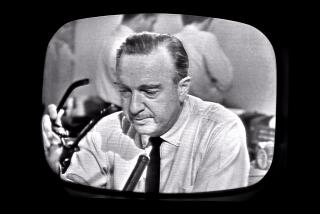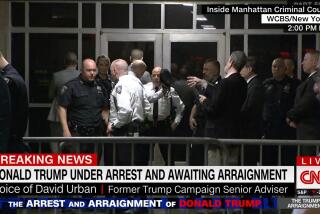In the Internet age, TV faced a dilemma
- Share via
NEW YORK — American television channels and networks were initially spared the thorny decision of whether to air graphic footage of Saddam Hussein’s execution after the Iraqi government declined to release video of the moments of his actual hanging early Saturday in Baghdad.
But hours later, a video of the hanging, which was apparently shot on a cellphone, surfaced on Arabic television channels and websites such as Google, underscoring how quickly controversial images rocket through cyberspace, whether or not there have been attempts to control them.
The jerky images show the noose being placed around Hussein’s neck and angry shouts exchanged between him and those in attendance. Hussein can be seen falling through the trapdoor as it opens, but the actual hanging is not visible. Moments later, the camera pans in and shows his face.
For most of Saturday, American TV relied on a tape made available earlier that showed only the moments leading up to the hanging.
CNN and Fox News also aired a grainy video of his body, his head twisted at a sharp angle as his shrouded corpse lay on a stretcher.
ABC, CBS and NBC decided to show a still photo from that footage, apparently made with a cellphone camera.
Both videos were originally shown by Iraqi television stations, which aired them several hours after the execution.
As of Saturday evening here, no American broadcast network or cable channel had aired the more explicit parts of the newer video, although Fox News ran a truncated version it said had been taken from Al Jazeera, ending after the noose is placed around Hussein’s neck. CBS News and CNN decided to air portions of the video before the trapdoor was released. ABC News said it would not use any of the newer video.
The origins of the newer video were not immediately clear, but its existence, and ready availability on the Internet, spotlighted the challenge that faces news organizations as Internet sites continue to supplant the traditional media as a source of information.
The possibility that video of the actual execution would be available had triggered intense discussions for the last two days among top executives at all the networks.
“It’s a very delicate issue because it could be gruesome material, but at the same time, he was a gruesome leader,” said David Rhodes, Fox News’ vice president of news, before the cellphone video of the hanging surfaced.
A cameraman from the Iraqi prime minister’s office apparently filmed the entire execution, but the government did not release the footage of the actual hanging. TV executives said they continued to receive conflicting reports about whether the Iraqi government would eventually release video of the actual execution, but added that the additional element was not necessary to convey the significance of the event.
“I think that looking at his face prior to him being executed, it sends a pretty powerful message,” said Bob Murphy, senior vice president at ABC News. “And then showing the conclusion of him afterward -- that’s a pretty complete story.”
More to Read
The biggest entertainment stories
Get our big stories about Hollywood, film, television, music, arts, culture and more right in your inbox as soon as they publish.
You may occasionally receive promotional content from the Los Angeles Times.










